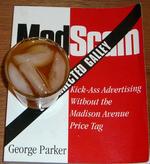While Advertising Age's Jonah Bloom has had issues with what we've written a couple times, we are, without doubt, sure he's going to take issue with what George Parker recently wrote about a column Jonah did on Crispin Porter + Bogusky backlash. Commenting on Bloom's statement about ads being "events" and hatred of Crispin's work actually being a good thing for the client, Parker wrote, "Listen Jonah baby, do me a favor, go and rent a copy of 'The Hucksters' and check out the scene where Sydney Greenstreet as 'The Soap Baron' spits up a huge gob of phlegm on the boardroom table to show agency guy Clark Gable how you go about catching the consumers attention. It's disgusting, just like holding a pile of dog shit, or having a crazed Nazi with a Nurse Diesel assistant shilling for VW. You don't have to spit in someone's face to get their attention."
Parker's gleeful criticism doesn't end there, adding, " And don't give me that shit about 'Ads as events.' They're fucking ADS... Get it. If I want an event, I'll go to the Super Bowl, and not for the ads. This is what happens when you have people who've never worked a day in advertising, writing about advertising. Pathetic!"
So who's right? No bullshit George who has years of advertising experience or CP+B-defending Jonah who's made a successful career in journalism?
Berlin-based Mairie Beautyman over at Treehugger says the movement to get society more enviro-conscious made some serious inroads this 2006. That's good news. And to illustrate the point there's some pretty yummy imagery:
"Let's play with metaphors and say Green in 2006 was a strapping football player, a quarterback with a helluva arm. This guy got right up in your face, and breathing down your neck, he told you, "I'm not going anywhere." Then, suited up in threads including post- consumer plastic, shod with vegan cleats, he threw his fair-trade-certified recycled pigskin right out of town."
Imaginative. But what's with all this talk? Somebody needs to send a creative team over there so they can do more than just pipe dream these delectable (and yeah, probably also recyclable) scenarios.
We passed on all the hype surrounding the K-fed Nationwide Super Bowl commercial offending fast food workers but after seeing the spot, we can't leave it alone. We have one thing to say: Get a Fucking Sense of Humor, People! For fuck's sake, can't we laugh at anything anymore? OK, so the commercial really isn't funny but that's not the point. The point is through some sort of American political correctness on steroids trend and an orgasmic proliferation of cause groups for every minute issue imaginable, we are no longer allowed to laugh at anything. We can't make fun of anything lest we offend someone. We can't tell joke unless they are of the scrubbed-clean second grade variety. We can't even call someone white or black - even though they are - lest we be labeled racist. Stop the insanity, please!
Part way through reading George Parker's new book, MadScam: Kick-Ass Advertising Without the Madison Avenue Price Tag, we informed George we had found the perfect coaster for our scotch. Amused, he agreed but told us to get off our ass and read the book. We did. And we can whole heartedly tell you you should too. With or without a glass of scotch. The man has things to say and things you won't hear from your average "I'm a hot shit marketer and everything I say is gold" flatulence. The man has been through it all and he has no problem telling marketers they don't need Madison Avenue for all their marketing needs.
more »
One trend that's been bubbling around in agencies for some time now might, aside from its other important benefits, may result in the elimination of the most dreaded operational activity: filling out time sheets. In recent history, following the shift from old-school 15 percent compensation, agencies have based revenue on the time it takes to complete a project mapped against the cost of hours to accomplish the project. There was then a shift to performance-based marketing that tied campaign performance to agency revenue. Now, the notion of value has been added to the compensation equation with several agencies, including Crispin Porter + Bogusky and Anomoly, setting fees based on the perceived value of the work they do for clients.
more »
If memory serves, after 9/11, wasn't it the French who sort of dragged their feet and made things difficult for the countries trying to tally together against Bin Laden? If so, that might explain this ad for French tree hugger site Defi Pour La Terre which thought it would be witty to transform the image of two trees into the twin towers burning on that fateful day. All to somehow equate the value of a tree to the value of a human life.
We not sure any amount of time passed makes this sort of thing OK. Then again, we're American. We knew people on Flight 93. The French? Well, perhaps they didn't know anyone who died that day or just feel Americans can't keep their hands out of other countries' issues. While the latter may be true, mocking a world event such as 9/11, at least for now, is still in very bad taste. And the French are supposed to know about taste, right?
Russian Orthodox Christmas happened last Sunday. To help Orthodox Russians celebrate, True ran a holiday campaign inviting men to meet Holly, who's apparently three different women. Copyranter notes it's stupid to 1) use non-member nameless bimbettes in a dating site ad, 2) give said fake bimbettes names, and 3) use the same name for multiple bimbettes in an ad series.
We got stuck on point 1 and can't seem to move forward. You mean True's ad models aren't actually members?! Think of all this time we've been sitting around planning what exactly we'd say to Holly when we finally meet her this season. (Considering there are at least three, we just figured it would help improve our odds.)
Brand Experience Lab occasionally releases a series of predictions we're invited to peruse from time to time. They recently updated their list to include a few profundities that might ring redundant considering '06 was ridden with questions of ad ethics, authenticity regarding social networking and "flogs" and the craze for congratulating consumers for being consumers, as best illustrated by Time and AdAge.
If you feel so inclined, read admonitions on why authenticity is key, why consumer capabilities on your website should reflect what can be done in your store, and why we're looking at an age in which everyone - including us - wants to criticize your shit.
Reverse Cowgirl directs us to a weird series of photos involving penises dolled up like faces to showcase KSUBI sunglasses. What struck us was not the penises but the other ads that appeared on the Papermag blog.
This Zune ad at the top of the page uses the same idea, manipulating elements of hands and fingers to create faces and features. Cool juxtaposition.
And we couldn't help smiling at the Dewar's ad whose tagline, "The quality of the article should be its greatest advertisement," was just too funny alongside the penis shots.
Oh, man. Can somebody please write a book or at least some kind of blog on the delicate feng shui involved in web ad placement?
Packaging Girlhood lists the best and worst 2006 marketing campaigns aimed at girls and their sometimes less-than-savvy guardians.
Worst includes the Dora the Princess campaign for turning an educational show into a stock purveyor of pretty-in-pink stereotypes. The Bratz Party Plane with juice bar also made the cut.
We always thought Bratz' eclipse over Barbie apt. Barbie was inspired by a German doll named Lilli, actually meant for adult males. That our 21st-century improvement over the Nordic sex kitten was a multi-ethnic series of skanks with DSL lips just kills us.
The list for Best include the Dove Campaign for Real Beauty whose crowning glory was the oft-spoofed Evolution ad of '06, and the transformation of Super Mario's Princess Peach into an entity capable of making her own rescues.
So cheers to real girls who say no lip gloss and aren't afraid to stomp in puddles.

|
|











